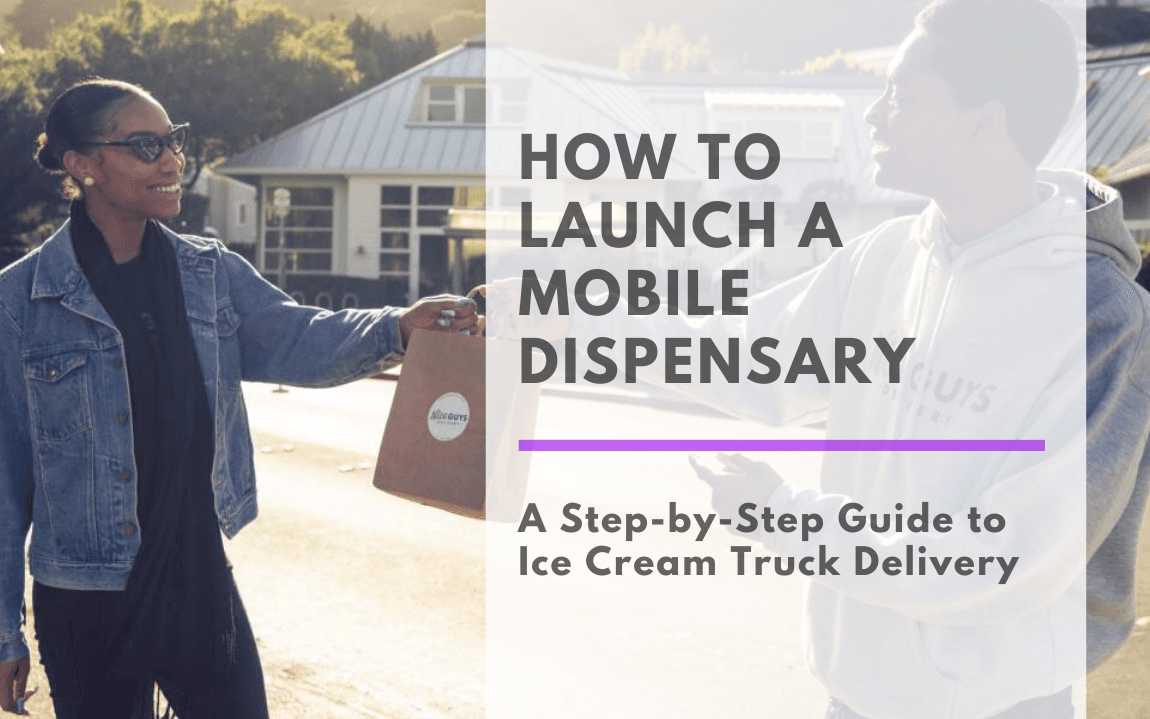Mobile cannabis dispensaries—also known as Ice Cream Truck Delivery or Dynamic Delivery—are licensed, inventory-stocked vehicles that serve customers within a designated cannabis delivery zone. Each vehicle has its own live menu that reflects what’s physically on board, and customers in that zone can place orders for express delivery.

With Meadow’s cannabis delivery software, each vehicle becomes a mobile retail hub—featuring real-time inventory tracking, customizable delivery zones, and automatic dispatching to the closest available driver. This advanced mobile dispensary model helps cannabis retailers:
- Serve broader areas with fewer return trips
- Reach new customers on the outskirts of traditional zones
- Run compliant, on-demand cannabis delivery with in-vehicle inventory
In this guide, we’ll walk through everything you need to launch or expand a mobile-first cannabis delivery operation—from licensing and vehicle setup to operational workflows and compliance—plus expert tools from Meadow, the trusted cannabis POS and delivery software platform powering mobile dispensaries across California and beyond.

Is Ice Cream Truck Delivery Legal?
The legality of mobile dispensaries varies by state and local jurisdiction. In California, for example, the Department of Cannabis Control permits dynamic delivery, allowing orders to be received, dispatched, and fulfilled on the road. This makes it possible to operate a mobile dispensary, provided all state and local regulations are met.
⚠️ Even if a state allows dynamic delivery, local municipalities may impose additional requirements or opt out altogether.
Step 1: Understand Your Local Licensing Requirements
Confirm that Dynamic Delivery is allowed in your operating area. Licensing requirements typically include:
- A delivery license from your state. In most cases, you’ll also need to secure a delivery license from the local jurisdiction where you plan to operate.
- Background checks for delivery drivers and operators
- Vehicle registration, insurance, inspection, and approval by your licensing body
- Security and compliance plans outlining operational procedures
You may also be required to submit detailed SOPs, demonstrate route tracking capabilities, or limit delivery activity to pre-approved areas. Regulators also typically require delivery manifests or delivery logs.
Navigating this process can be complex. Meadow has worked with operators across California, New Jersey and Michigan to design compliant delivery workflows that satisfy regulators and set dispensaries and delivery operators up for success.
Step 2: Choose the Right Vehicle for Your Mobile Dispensary

Ensure vehicles meet your state’s cannabis transport requirements. Vehicle Requirements vary by state, but the below are commonly enforced across cannabis delivery programs. Refer to your state’s cannabis bureau or department of transportation for your state-specific vehicle guidelines.
Your vehicle must have:
- Locked, secured storage
- GPS tracking
- Adequate insurance
Step 3: Build a Compliant Mobile Delivery Workflow
A successful mobile cannabis delivery business must track orders, inventory, and customer data in real time.
Typical workflow:
- Orders are placed online via your eCommerce menu
- Drivers receive new orders directly to a mobile device
- ID is verified before the product is handed over
- Signature and delivery details are logged
- Inventory is automatically updated after each transaction
Ice Cream Truck workflows are more dynamic than hub-and-spoke or store-based delivery. Routes may change on the fly, and orders must still meet state compliance. Meadow helps operators follow every step of the workflow—accurately and automatically.
👉 Read more about Meadow’s delivery tools →
Step 4: Set Up Your Technology for Success

Running a mobile dispensary requires more than a van—it requires a strong digital backbone. Your tech stack should include:
- A mobile-friendly cannabis POS system
- Dynamic delivery routing and dispatch tools
- ID verification at the point of delivery
- Real-time inventory syncing with compliance reporting built in
Too many operators stitch together multiple tools for POS, routing, menus, and compliance. This slows down operations and increases error risk.
Meadow’s platform was purpose-built to support mobile and dynamic delivery models. It syncs every sale to Metrc, updates your online menu automatically, and gives you a single dashboard to track it all.
👉 Explore Meadow’s POS features →
Step 5: Hire and Train Your Mobile Dispensary Team
Your drivers are more than couriers—they’re the face of your business. Look for team members who are punctual, detail-oriented, and customer-focused.
Make sure every delivery staff member is trained in:
- Verifying IDs and checking for duplicates
- Secure product handling and in-vehicle protocols
- Compliant delivery reporting procedures
Well-trained drivers reduce risk, improve customer retention, and make compliance smoother. Meadow’s built-in workflows and driver app help standardize best practices across your team.
Step 6: Launch Your Mobile Dispensary and Start Promoting It
Once your vehicle, licenses, and team are in place, it’s time to launch. Mobile dispensaries offer a unique opportunity to engage with local communities.
Promotion ideas:
- Host a grand opening with (compliant) giveaways
- Partner with events, festivals, or farmers markets
- Use targeted SMS or email campaigns to announce new delivery zones
- Add geofenced promos to encourage repeat business or pop-up neighborhood routes to test new markets.
👉 Want to see what a mobile operation looks like? See how Abide did it at BottleRock →
Inventory Management & Restocking for Dynamic Delivery
Unlike scheduled delivery, where inventory is packed per order, Dynamic Delivery vehicles carry pre-loaded inventory available for immediate sale. You’ll need systems in place to load inventory, track sales in real time, and restock efficiently.
Best practices:
- Start with a curated product mix based on fast movers and past sales
- Use data to optimize what gets loaded onto each vehicle
- Restock during shift transitions or slow periods
- Run end-of-day cycle counts to keep inventory accurate
With the right delivery software, vehicle menus update automatically as items are sold, preventing oversells and reducing the risk of compliance violations.
Building the Right Team for Mobile Delivery
Running a mobile dispensary requires more than just licensed drivers. Your team needs to understand compliance, customer service, and the ins and outs of real-time delivery operations.
Common roles include:
- Drivers: Licensed, trained, and capable of managing in-the-field situations
- Dispatch Leads: Monitor orders, reroute drivers, and coordinate restocking
- Inventory Specialists: Ensure proper loading and reconciliation of inventory
- Customer Support: Handle real-time order issues or customer questions
Training should cover:
- Verifying customer ID and age
- Secure handoffs and delivery procedures
- Safety protocols and incident reporting
- Using your delivery software and POS system correctly
Optimizing the Customer Experience

Customers ordering from a mobile dispensary should have a seamless, intuitive experience from start to finish. With Dynamic Delivery, each vehicle’s menu reflects the real-time inventory on board—so shoppers only see what’s actually available in their zone.
To deliver a great ecommerce experience:
- Use customized menu layouts that match your brand and showcase key products
- Highlight product availability with real-time syncing to your vehicle’s inventory
- Offer fast, simple checkout with options for cashless payment
- Provide clear, accurate delivery ETAs and order confirmation
- Ensure menus are mobile-friendly and easy to browse
Meadow’s ecommerce platform integrates directly with your POS and delivery workflows, keeping your menus compliant, your operations efficient, and your customers happy.
Common Challenges When Launching a Mobile Dispensary (and How to Avoid Them)
Running a cannabis delivery business on wheels comes with complexity. Here’s what operators often face—and how Meadow helps:
Navigating shifting regulations Regulations change all the time. Meadow stays on top of updates, builds the new compliance tools and workflows into the platform, and helps clients adapt quickly.
Managing real-time inventory Mobile inventory must match what’s reported to Metrc. Meadow syncs each transaction to avoid discrepancies.
Disconnected Data & Tools Managing separate systems for delivery, POS, eCommerce, and compliance can slow you down and drive up costs. Meadow’s all-in-one platform keeps everything in sync.
Take your dispensary on the road. Meadow powers dynamic cannabis delivery from compliance to customer service.
FAQs about Mobile Cannabis Dispensaries & Ice Cream Truck Delivery
How do I know if this model is allowed in my state or city? Cannabis delivery regulations vary widely. Some jurisdictions allow mobile delivery models like Dynamic Delivery; others may restrict delivery to scheduled or pre-packed orders. Check your state and local regulations carefully—or work with a provider that understands your market and can help you navigate compliance.
What kind of license do I need for Dynamic Delivery? You’ll typically need a retail delivery license that allows inventory in vehicles. In some states, this may fall under a non-storefront retail license or a delivery endorsement. You’ll also need to register your vehicles and submit documentation outlining your SOPs, staffing, and inventory protocols.
What happens if I run out of a product mid-route? Customers only see what’s in stock on the vehicle assigned to their zone. If something sells out, it automatically disappears from the live menu, helping you avoid canceled orders and negative customer experiences.
Can I offer both scheduled and dynamic delivery? Yes. Many operators use a hybrid model to serve regulars with scheduled delivery while using mobile dispensaries to expand reach. The right software should support both workflows seamlessly within the same system.
How long does it take to launch a mobile delivery operation? Depending on your state’s licensing process and vehicle readiness, it could take anywhere from 60–90 days to get started. Having a clear plan, the right team, and trusted technology can accelerate your timeline.
How many vehicles do I need to start? ``You can start with just one and scale as needed. Start small, learn what works, and expand zones and fleet size based on demand. A good delivery platform will help you maximize efficiency with smart routing and dispatch tools.
Ready to launch your mobile dispensary? Meadow’s delivery management tools make it easy to stay compliant and efficient.



